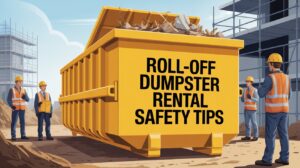
Same Day Delivery Phoenix

Call Now For Instant Quote!
Renting a roll-off dumpster can streamline debris removal on any construction, renovation, or clean-out project but without the right precautions, it can also introduce serious hazard prevention for dumpsters risks. From tipping accidents to hidden trip hazards, this guide delivers actionable Roll-Off Dumpster Rental Safety Tips so you can choose the right dumpster, position it safely, load it properly, and comply with regulations all while protecting people, property, and the planet.

Selecting an appropriate container is your first line of defense against overloading risks and prevention. A dumpster that’s too small leads to overfill, debris spillage, and tipping too large, and you pay for excess capacity you won’t use.
| Size (yards) | Dimensions (L×W×H) | Ideal Uses |
|---|---|---|
| 10 | 12ft × 8ft × 3.5ft | Small cleanouts, minor home renovations |
| 20 | 22ft × 8ft × 4ft | Mid-size remodels, roofing tear-offs |
| 30 | 22ft × 8ft × 6ft | Large renovations, single-family home construction |
| 40 | 22ft × 8ft × 8ft | Major commercial builds, multi-family cleanouts |
Proper placement minimizes trip hazards near dumpsters and prevents vehicle collisions, overhead-wire contact, and slope-related tip-overs.
Prevent tipping and overloading by following these proper dumpster loading techniques:
Maintaining a hazard-free worksite is essential to protect laborers and visitors alike.
Mandatory PPE
Hard hats to guard against falling debris.
Steel-toe boots to prevent crush injuries.
High-visibility vests for hard-to-see loading areas.
Heavy-duty gloves to shield against sharp edges.
Site Housekeeping
Clear walkways of stray nails, wires, and refuse.
Sweep or blow dust daily respiratory hazards escalate when debris accumulates.
Place temporary fencing around open dumpsters on multi-family or commercial sites.
Understanding OSHA compliance for dumpsters and local ordinances is non-negotiable.
OSHA Waste Container Standards
No specific OSHA standard for dumpsters, but covered under general requirements:
29 CFR 1926.250(a): Containers must be secured against sudden movement.
29 CFR 1926.250(b): Employees must stand clear when dumping.
Local Weight & Permit Rules
Municipal codes often cap dumpster weights on residential streets (e.g., 2-ton max).
Obtain permits for curbside placement in many cities—failure can result in fines up to $500 per day.
Handling hazardous materials in dumpsters demands strict protocols to protect people and the environment.
Identify Prohibited Items
Paints, solvents, pesticides, asbestos, batteries, electronic waste.
Use Designated Containers
Sealable drums or lined roll-offs for liquid or chemical waste.
Label and Document
Mark containers clearly: “Hazardous Waste – Do Not Mix.”
Maintain a manifest documenting pickup and disposal per EPA regulations.
Extreme weather can magnify overloading risks and prevention and create new hazards:
Rain & Snow
Wet debris is heavier—recalculate weight estimates.
Ice buildup on walls increases slip risk when loading.
High Winds
Secure lightweight debris with tarps to prevent projectiles.
Delay delivery or pickup if gusts exceed 30 mph.
What’s the best way to choose a dumpster size?
Consider project scope, debris density, and local weight limits refer to our size chart above for guidance.
Can I load hazardous materials in a standard roll-off?
No use EPA-compliant drums or specialty roll-offs and maintain a hazardous waste manifest.
How close can a dumpster be to overhead power lines?
Maintain at least 10 feet of clearance when loading, unloading, or positioning osha.gov.
Are there OSHA-mandated training requirements?
While no dumpster-specific training standard exists, all workers must be trained on general equipment safety (29 CFR 1926.21).
What penalties apply for non-compliance with local permits?
Fines vary by jurisdiction but can exceed $500 per day for unauthorized curbside placement.
How can I prevent tipping on uneven ground?
Level the site with cribbing blocks, use wheel chocks, and position the container rear downhill.
Ensuring Roll-Off Dumpster Rental Safety Tips aren’t just good practice they’re essential safeguards that protect your crew, clients, and bottom line. From selecting the right container to mastering proper loading techniques, donning the correct PPE, and staying compliant with OSHA and local rules, a proactive safety plan transforms dumpster rental from a liability into an asset. Follow these guidelines, train your team thoroughly, and you’ll keep accidents, fines, and project delays firmly in check.